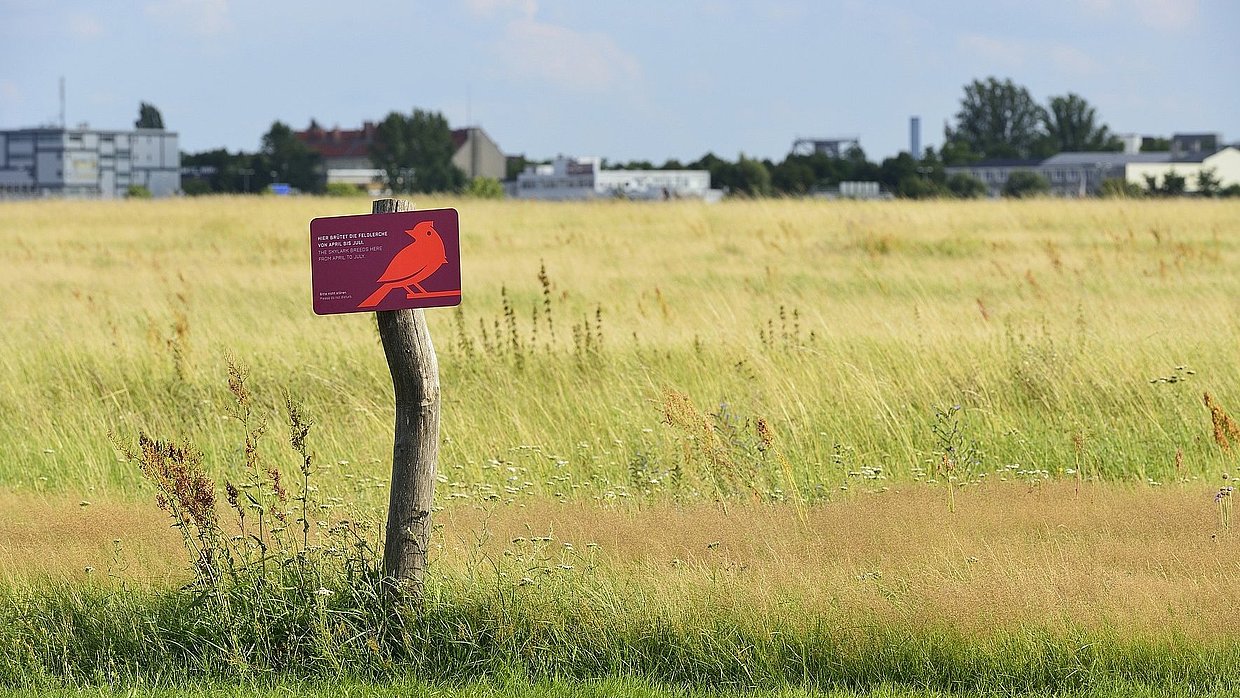SKYLARK PROTECTION ZONE
Nature & Environment
The skylark (Alauda arvensis) is one of the endangered bird species in Germany. The bird, which grows up to 19 cm, can be recognised by its long tail and dark-striped, beige to reddish-brown colouring and pale belly. The skylark is a ground-breeder and hides its nests in self-scooped hollows in the grass.

Monitoring the avifauna of Tempelhofer Feld
In 2005, the avifauna of the site, which was still used as an airport at the time, was recorded almost completely for the first time. In order to conserve the species recorded in 2005 and especially the skylark, a concept was developed in the run-up to the opening of Tempelhofer Feld in May 2010:
- Approximately the eastern half of the area south of the southern runway was fenced off to prevent access.
- The area between the former landing and take-off runways was provided with a row of bollards at a distance of 15 metres from the landing and take-off runways, with information boards at regular intervals indicating a ban on entering the area from March/April to August. This no-entry rule will be monitored by the parking service and enforced if necessary.
- All other meadow areas remain unprotected against trespassing.
- The entire study area can only be entered via a total of 9 entrances; these entrances are open between 6:00 and 22:30 on average during the study period. At night and in the early morning, the study area is thus largely free of human presence.
The breeding birds of the approx. 300 ha Tempelhofer Feld have been repeatedly qualitatively and quantitatively investigated since its opening with the help of the territorial mapping method. The questions of the study are:
- What changes in the avifauna have occurred since the opening?
- What is the effect of opening the site all year round on breeding birds?
- Are the different protection zones suitable and sufficient to ensure the protection of rare and endangered species?
- How and where can better protection be achieved?
- What maintenance measures will be necessary in the future to preserve the existing range of species?
- Is there a need for further research?
![[Translate to English:] Tempelhofer Feld - Monitoring der Avifauna 2021 [Translate to English:] Tempelhofer Feld - Monitoring der Avifauna 2021](/fileadmin/_processed_/4/5/csm_tempelhoferfeld_dokumente_monitoring_avifauna_2021_altenkamp_5594dcda08.png)
![[Translate to English:] Tempelhofer Feld - Monitoring der Avifauna 2020 [Translate to English:] Tempelhofer Feld - Monitoring der Avifauna 2020](/fileadmin/_processed_/0/2/csm_tempelhoferfeld_dokumente_monitoring_avifauna_2020_906cffc47c.png)
![[Translate to English:] Tempelhofer Feld - Monitoring der Avifauna 2018 [Translate to English:] Tempelhofer Feld - Monitoring der Avifauna 2018](/fileadmin/_processed_/8/f/csm_tempelhoferfeld_dokumente_monitoring_avifauna_2018_e80f7bf597.png)
![[Translate to English:] Tempelhofer Feld - Monitoring der Avifauna 2016 [Translate to English:] Tempelhofer Feld - Monitoring der Avifauna 2016](/fileadmin/_processed_/e/3/csm_tempelhoferfeld_dokumente_monitoring_avifauna_2016_8a58234fca.png)
![[Translate to English:] Tempelhofer Feld - Monitoring der Avifauna 2015 [Translate to English:] Tempelhofer Feld - Monitoring der Avifauna 2015](/fileadmin/_processed_/0/f/csm_tempelhoferfeld_dokumente_monitoring_avifauna_2015_e626748192.png)
![[Translate to English:] Tempelhofer Feld - Monitoring der Avifauna 2014 [Translate to English:] Tempelhofer Feld - Monitoring der Avifauna 2014](/fileadmin/_processed_/2/c/csm_tempelhoferfeld_dokumente_monitoring_avifauna_2014_af586d6003.png)
![[Translate to English:] Tempelhofer Feld - Monitoring der Avifauna 2013 [Translate to English:] Tempelhofer Feld - Monitoring der Avifauna 2013](/fileadmin/_processed_/1/0/csm_tempelhoferfeld_dokumente_monitoring_avifauna_2013_6c37be796c.png)
![[Translate to English:] Tempelhofer Feld - Monitoring der Avifauna 2012 [Translate to English:] Tempelhofer Feld - Monitoring der Avifauna 2012](/fileadmin/_processed_/9/1/csm_tempelhoferfeld_dokumente_monitoring_avifauna_2012_ffe6b64c34.png)
![[Translate to English:] Tempelhofer Feld - Monitoring der Avifauna 2011 [Translate to English:] Tempelhofer Feld - Monitoring der Avifauna 2011](/fileadmin/_processed_/8/2/csm_tempelhoferfeld_dokumente_monitoring_avifauna_2011_f2c6771b0a.png)
![[Translate to English:] Tempelhofer Feld - Monitoring der Avifauna 2010 [Translate to English:] Tempelhofer Feld - Monitoring der Avifauna 2010](/fileadmin/_processed_/c/8/csm_tempelhoferfeld_dokumente_monitoring_avifauna_2010_f92f6df521.png)